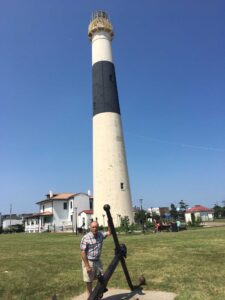Hearken back to the great age of 19th century sailing when giant frigates and long-haul sea clippers passed through the deep waters of the Atlantic coast line and around the world. They carried freight, agricultural cargo, and passengers from continent to continent. Their towering masts and myriad sails could propel those graceful ships at speeds of 20 knots across the sea.
Going to sea was a high-risk venture, and great faith and mariner skills were essential for the safe return to port of any ship of that era. The sea was and remains a perilous pathway.
Those ships did not have the benefit of electronic navigation, radar, or modern methods of safety for seagoing transit. Sea captains sailed around the earth with hand-drawn charts, handheld sextants, and navigated using the sun, the stars, and the moon.
Lighthouses assisted 19th century mariners in their ships’ voyages around the world. They were typically 100- to 200-foot high brick, cement, or stone towers. The structures were built on cliffs or high bluffs above a rough shoreline or upon barrier islands along shallow sea coasts. They shone a light far to sea that in the early days burned kerosene and focused its flame through a Fresnel lens.
The Absecon Lighthouse, in Atlantic City, New Jersey, is an excellent example of the navigation aid to mariners. The lighthouse is on the National Register of Historic Places. Visitors can see the lighthouse, the lighthouse keeper’s home, and historical exhibits in a museum on site. They may climb this 171-foot high tower to see an extensive view of the beaches and casinos of Atlantic City and the islands that surround the marshlands and inlets of Absecon Bay.
The Absecon Lighthouse began its service to mariners one night in 1857 when its kerosene flame was projected nearly 20 nautical miles out to sea. It was then the home and the duty of the first lighthouse head keeper, Mr. Daniel Scull. He lit and extinguished the flame at sunset and sunrise Ñ every day, maintained the lens and the machinery that revolved it, preserved the buildings, the tower, and all of the properties. He was the full time custodian of this vital, life-protecting asset.
Many modernizations occurred over the subsequent decades, including changing to electric navigation lighting in 1925 during the tenure of Knud Hansen, the Head Lighthouse Keeper from 1914 to 1933. But times changed, and Atlantic City became a popular resort, known for the Miss America contest, nightclubs with music and comedy, elaborate hotels, gambling, spas, and miles of sandy beaches.
The Absecon Lighthouse’s mission became obsolete. Mr. Hansen oversaw its decommissioning, and the light was extinguished on July 11, 1933, under his guidance as the last head lighthouse keeper.
Today the historic Absecon Lighthouse is administered by the Inlet Public-Private Association Inc. The lighthouse and exhibits are located at Pacific and Rhode Island Avenues in Atlantic City and are open to the public for nominal fees.
Atlantic City has restaurants, casinos, beaches, and its dazzling boardwalk of many miles. Entertainment and nightclubs abound. Opportunities exist for offshore fishing, sailing, and parasailing, plus all the restaurants to satisfy you upon return.
If you are intrigued by history and nostalgia and unique stories of America, a visit to Atlantic City will offer an excellent port of call.
The author is an avid hiker and traveler and operates the Piedmont Trekkers hiking club. Interested hikers and outdoor enthusiasts with questions may reach him at [email protected]
ON THE WEB
Absecon Lighthouse
www.abseconlighthouse.org
Atlantic City entertainment
www.atlanticcitynj.com/events

Let's keep in touch!
Keep up with the latest OutLook by the Bay information by signing up here. We promise not to waste your time.


